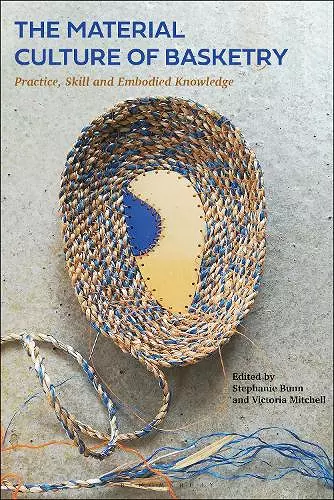The Material Culture of Basketry
Practice, Skill and Embodied Knowledge
Victoria Mitchell editor Stephanie Bunn editor
Format:Paperback
Publisher:Bloomsbury Publishing PLC
Published:18th May '23
Currently unavailable, and unfortunately no date known when it will be back

Presents the discipline of basketry as a culturally significant practice, a mode of sustainable craft and design, and a socially beneficial source of skill and care.
This book celebrates basketry as a culturally significant skilled practice and as a theoretically rich discipline which has much to offer contemporary society. While sometimes understudied and underappreciated, it has much in common with mathematics and engineering, art, craft and design, and can also act as a socially beneficial source of skill and care.
Contributors show how local knowledge of materials, plants and place are central to the craft. Case studies include the skill in weaverbird nest building (challenging how we perceive learning in craft and nature), an engineer’s perspective on twining Peruvian grass bridges, and the local knowledge embodied in Pacific plaited patterns and knots. Photo-essays explore materials and techniques from the point of view of artists, anthropologists and mathematicians, revealing how the structure and skill in basketwork illustrate a significant form of textile technology. Thus, the book demonstrates that the textures, patterns and geometric forms that emerge through basketwork reflect an embodied knowledge which expresses mathematical and engineering comprehension.
The therapeutic value of the craft is recognised through a selection of case studies which consider basketry as a healing process for patients with brain injury, mental health problems, and as a memory aid for people living with dementia. This reclaims basketry’s significant role in occupational therapy as an agent of recovery and well–being. Basketry's inherently sustainable nature is also considered, demonstrating the continuation of basketry in spite of handwork’s general decline and profiling new and recycled materials. Above all, the book envisages basketry as an intellectually rewarding means of knowing. It presents the craft as embodying care for skilled making and for the social and natural environments in which it flourishes.
At a time when we need, more than ever, to reconnect with each other and our environment, The Material Culture of Basketry is a reminder of how the most simple things can be so meaningful and sophisticated. This exploration of how the process of basketry has influenced our history, culture and global economy is both surprising and fascinating. It is a rich and compelling case for craft skills and material knowledge. -- Rosy Greenlees, Crafts Council, UK
The Material Culture of Basketry is a tour de force. The spotlight is on baskets and basket making, but the chapters in this collection are about far more. Taking a boldly interdisciplinary approach, objects and artisanal practices become effective means for authors to probe a vast range of anthropological concerns, including cultural meaning; sociality, well-being and recovery; embodied skill, situated problem solving and the intelligent hand; ecology and place-making; human origins, history and development; and techniques of making that we share with fellow species. The significance of this book is far reaching and will surely be on interest to scholars and craftspeople alike. -- Trevor H J Marchand, SOAS University of London, UK
Baskets stand for a fast vanishing connective world. No robot can make a basket. A retired consultant pathologist discusses making basket with brain injury patients in a remarkable interdisciplinary collection is written by diverse contributors - basket makers, mathematicians, ethnographers, and archaeologists. Baskets - threatened by plastic containers of all kinds, their materials harder to access, their rhythmic, complex patterns growing unfamiliar - have much to teach us. The process of making baskets throws light on embodied knowledge, changing global economies and the subtle interactions between humans and plant materials. They are not simply evidence of technique, being also records of social relations. This visionary and sustaining book should be read by anyone concerned for the future of this planet. -- Tanya Harrod, Founder Editor of the Journal of Modern Craft, UK
ISBN: 9781350359901
Dimensions: 246mm x 188mm x 20mm
Weight: 914g
312 pages